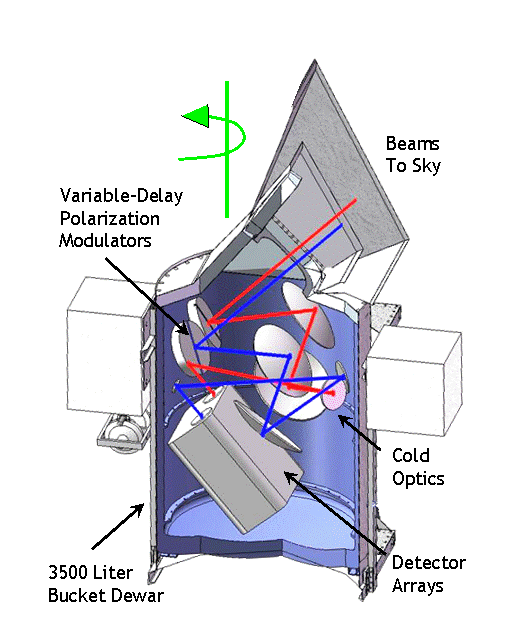PIPER
The Primordial Inflation Polarization Explorer
The Primordial Inflation Polarization Explorer (PIPER) is a balloon-borne mission to measure the polarization of the cosmic microwave background (CMB) in search of the signature of primordial gravity waves excited by an inflationary epoch in the early universe.
The existence of a gravity-wave background at detectable levels is a generic prediction of inflationary models. The detection of these gravity waves through their unique signature in the polarization of the remnant light from the Big Bang would have profound consequences for both cosmology and high-energy physics. Not only would it establish inflation as a physical reality, it would also provide a measurement of the relevant energy scale, probing physics at energies over a trillion times higher than accessible through particle accelerators.
PIPER consists of two identical telescopes cooled to 1.5 K within a large (3 meter tall, 3500-liter capacity) liquid helium bucket dewar. There are no windows between the LHe-cooled telescope and the ambient environment—PIPER uses the efflux of boiloff helium gas to prevent the atmosphere at balloon altitudes from condensing on the optics. The unusual cryogenic design provides mapping speed a factor of 10 better than any other CMB instrument, allowing PIPER to achieve sensitivities with over- night balloon flights from New Mexico that would otherwise require 10-day flights from Antarctica.
Each of PIPER's twin telescopes illuminates a pair of 32 × 40 element transition-edge superconducting detector arrays for a total of 5120 detectors. A Variable-Delay Polarization Modulator (VPM) injects a time-dependent phase delay between orthog- onal linear polarizations to cleanly separate polarized from unpolarized radiation. The combination of background-limited detectors with fast polarization modulation allows PIPER to rapidly scan large areas of the sky. PIPER is the only balloon mission capable of observing on angular scales larger than 20°, where the inflationary signal is expected to be largest.
PIPER will map the sky in both linear and circular polarization, at wavelengths of 1500, 1100, 850, and 500 mm (frequencies 200, 270, 350, and 600 GHz). It will detect the signature of inflationary gravity waves to a factor of three fainter than the lowest value predicted by inflationary models. The unbiased survey of submillimeter polarization will also provide an important probe of interstellar cirrus dust and the large-scale structure of our galaxy's magnetic field and will be the first sky survey in circular polarization at these wavelengths.

